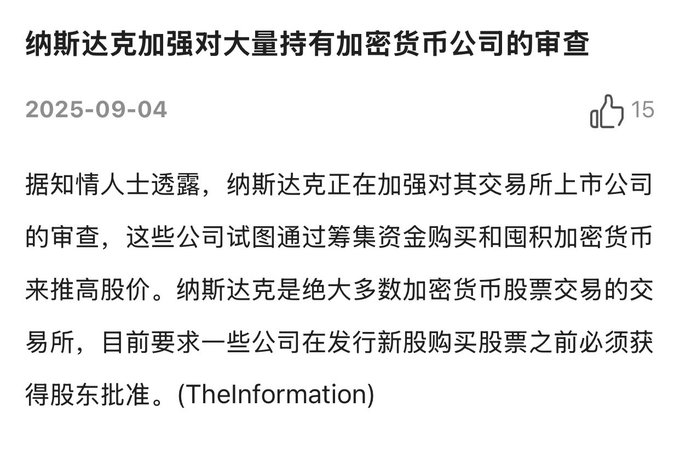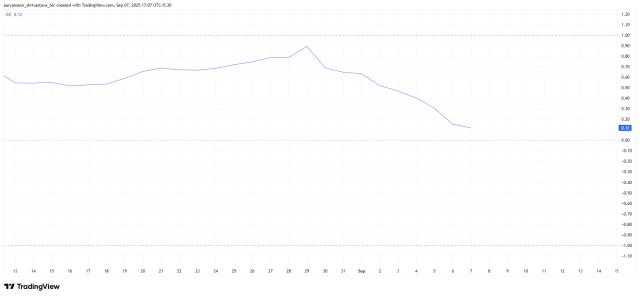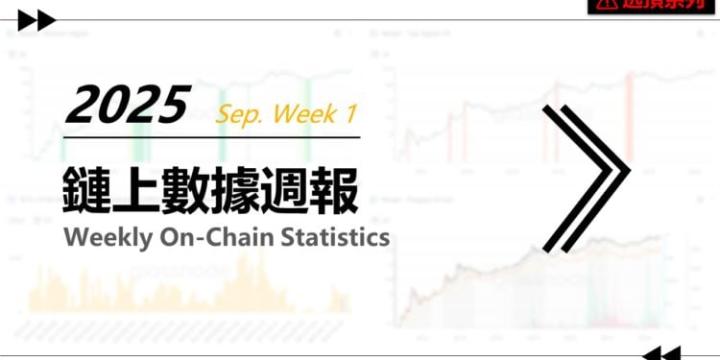Let's talk about the impact of Nasdaq's review of MicroStrategy Treasury last night. I saw many people were pessimistic about this today. Last night I said that this was like stepping on the brakes, cooling down and slowing down. I want to talk about it in detail. The core is: for the real MicroStrategy Treasury, the impact is actually not big. It is just an additional process link, but for companies that use routines, the difficulty may increase by several levels. How to understand it? Nasdaq's requirement is that the issuance of new shares to raise funds for the purchase of crypto assets requires shareholder approval, which means holding a shareholders' meeting to disclose the purchase scale, strategy, and risk warnings, and let shareholders vote. This involves two stages: the preparation stage of MicroStrategy Treasury and the stage of transformation into MicroStrategy Treasury. For institutions planning to establish a MicroStrategy treasury company, the key is choosing a shell company. For listed companies with market capitalizations in the millions or tens of millions of dollars, a private placement of hundreds of millions of dollars in pipeline financing is essentially a reverse takeover. From the time of planning to the announcement, there's no market information at all; the planning agency often colludes with the major shareholders of the US-listed company, and the announcement is made immediately. The impact of the new regulations is that if you still want to choose a US-listed shell company listed on the Nasdaq, you'll likely want to choose a company where the major shareholder holds absolute control. This means that even if a shareholders' meeting is held, the major shareholder has the final say. Of course, the downside is that holding a shareholders' meeting and issuing an announcement is equivalent to pre-announcement of the plan, which can potentially lead to a pre-emptive market reaction. For institutions planning a MicroStrategy treasury company, they don't want a pre-emptive market reaction. Of course, choosing a US-listed shell company listed on the New York Stock Exchange eliminates this concern. 2. For listed companies that have transitioned to a MicroStrategy treasury model, previously announced financing plans are likely to continue to be executed. However, if new shares are issued, a shareholder meeting will be held, and the financing scale and buy-and-hold strategy will need to be disclosed to all shareholders. This is where management's ability to paint a BTC is tested. After all, issuing new shares will dilute the interests of existing shareholders, and they are reluctant to do so. However, the treasury model dictates that only by continuously raising funds and hoarding coins can the company's value continue to increase. Otherwise, the value will gradually weaken. In this case, as long as the picture is good, existing shareholders will be willing to accept it. Of course, the shareholders' meeting only requires the consent of 2/3 of the shareholders. For the management, the key is to obtain the consent of the major shareholders. Often the interests of the major shareholders and the management are consistent. In some treasury companies, the management is pushed to the front by the major shareholders. So here we go back to the point at the beginning: "For genuine micro-strategy treasury companies, the impact is actually not significant, it is just an additional process step, but for companies that use routines, the difficulty may increase by several levels." The real MicroStrategy Treasury company model is very simple: financing to buy and hoard coins, with high transparency. There is nothing else, and the probability of shareholders approving it is high. If a company like MicroStrategy uses gimmicks, such as attempting to buy tokens acquired earlier at a low price from a major shareholder after raising funds, small and medium-sized shareholders might question whether this is a transfer of interests. Unless management and the major shareholder can secure the approval of two-thirds of shareholders, the proposal is likely to be rejected. This raises the bar several notches, and the previous practice of arbitrary financing plans and purchasing strategies, which were all black-box operations, can no longer be achieved. Currently, most micro-strategy treasury companies are listed on the Nasdaq, with a very small number on the New York Stock Exchange. Nasdaq is primarily home to numerous shell companies with market capitalizations ranging from a few million to a few tens of millions of dollars. BMNR, which is listed on the NYSE, is not currently subject to Nasdaq scrutiny. Furthermore, it has likely only executed a small portion of the $20 billion IPO financing plan announced in mid-August. Nasdaq's review is actually a good thing, allowing real micro-strategy treasury companies to stand out. It is equivalent to driving out "bad money" and allowing "good money" to develop better.
This article is machine translated
Show original

qinbafrank
@qinbafrank
09-04
代币证券化DAT模式被踩刹车,今天美股微策略DAT类型公司股价全部大跌,主要原因还是这个:纳斯达克正在加强对旗下上市公司通过融资购买加密货币来推高股价行为的审查。具体要求就是:部分公司在发行新股购买加密货币前必须获得股东批准。 x.com/qinbafrank/sta…

From Twitter
Disclaimer: The content above is only the author's opinion which does not represent any position of Followin, and is not intended as, and shall not be understood or construed as, investment advice from Followin.
Like
Add to Favorites
Comments
Share







